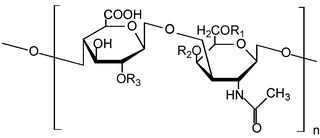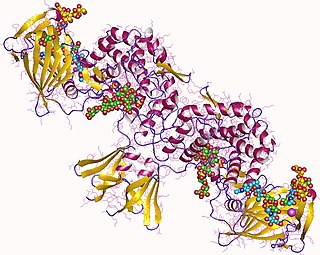Related Research Articles

Glycosaminoglycans (GAGs) or mucopolysaccharides are long, linear polysaccharides consisting of repeating disaccharide units. The repeating two-sugar unit consists of a uronic sugar and an amino sugar, except in the case of the sulfated glycosaminoglycan keratan, where, in place of the uronic sugar there is a galactose unit. GAGs are found in vertebrates, invertebrates and bacteria. Because GAGs are highly polar molecules and attract water; the body uses them as lubricants or shock absorbers.

Heparan sulfate (HS) is a linear polysaccharide found in all animal tissues. It occurs as a proteoglycan in which two or three HS chains are attached in close proximity to cell surface or extracellular matrix proteins. In this form, HS binds to a variety of protein ligands, including Wnt, and regulates a wide range of biological activities, including developmental processes, angiogenesis, blood coagulation, abolishing detachment activity by GrB, and tumour metastasis. HS has also been shown to serve as cellular receptor for a number of viruses, including the respiratory syncytial virus. One study suggests that cellular heparan sulfate has a role in SARS-CoV-2 Infection, particularly when the virus attaches with ACE2.

Syndecan 1 is a protein which in humans is encoded by the SDC1 gene. The protein is a transmembrane heparan sulfate proteoglycan and is a member of the syndecan proteoglycan family. The syndecan-1 protein functions as an integral membrane protein and participates in cell proliferation, cell migration and cell-matrix interactions via its receptor for extracellular matrix proteins. Syndecan-1 is a sponge for growth factors and chemokines, with binding largely via heparan sulfate chains. The syndecans mediate cell binding, cell signaling, and cytoskeletal organization and syndecan receptors are required for internalization of the HIV-1 tat protein.

Heparosan-N-sulfate-glucuronate 5-epimerase is an enzyme with systematic name poly( -beta-D-glucuronosyl- -N-sulfo-alpha-D-glucosaminyl) glucurono-5-epimerase. This enzyme catalyses the following chemical reaction
In enzymology, a [heparan sulfate]-glucosamine 3-sulfotransferase 1 is an enzyme that catalyzes the chemical reaction
In enzymology, a [heparan sulfate]-glucosamine 3-sulfotransferase 2 is an enzyme that catalyzes the chemical reaction

Heparanase, also known as HPSE, is an enzyme that acts both at the cell-surface and within the extracellular matrix to degrade polymeric heparan sulfate molecules into shorter chain length oligosaccharides.
In enzymology, a N-acetylglucosaminyl-proteoglycan 4-beta-glucuronosyltransferase is an enzyme that catalyzes the chemical reaction

Glypican-1 (GPC1) is a protein that in humans is encoded by the GPC1 gene. GPC1 is encoded by human GPC1 gene located at 2q37.3. GPC1 contains 558 amino acids with three predicted heparan sulfate chains.

Sulfatase 1, also known as SULF1, is an enzyme which in humans is encoded by the SULF1 gene.

Extracellular sulfatase Sulf-2 is an enzyme that in humans is encoded by the SULF2 gene.

Xylosyltransferase 2 is an enzyme that in humans is encoded by the XYLT2 gene.

Heparan sulfate glucosamine 3-O-sulfotransferase 3A1 is an enzyme that in humans is encoded by the HS3ST3A1 gene.

Heparan sulfate glucosamine 3-O-sulfotransferase 1 is an enzyme that in humans is encoded by the HS3ST1 gene.

Heparan sulfate glucosamine 3-O-sulfotransferase 3B1 is an enzyme that in humans is encoded by the HS3ST3B1 gene. Heparan sulfate biosynthetic enzymes are key components in generating myriad distinct heparan sulfate fine structures that carry out multiple biologic activities. The enzyme encoded by this gene is a member of the heparan sulfate biosynthetic enzyme family. It is a type II integral membrane protein and possesses heparan sulfate glucosaminyl 3-O-sulfotransferase activity ( HS3ST3A1). The Sulfotransferase domain of this enzyme is highly similar to the same domain of heparan sulfate D-glucosaminyl 3-O-sulfotransferase 3A1 and these two enzymes sulfate an identical disaccharide. This gene is widely expressed, with the most abundant expression in liver and placenta.

Heparan sulfate glucosamine 3-O-sulfotransferase 2 is an enzyme that in humans is encoded by the HS3ST2 gene.

In biochemistry, carbohydrate sulfotransferases are enzymes within the class of sulfotransferases which catalyze the transfer of the sulfate functional group to carbohydrate groups in glycoproteins and glycolipids. Carbohydrates are used by cells for a wide range of functions from structural purposes to extracellular communication. Carbohydrates are suitable for such a wide variety of functions due to the diversity in structure generated from monosaccharide composition, glycosidic linkage positions, chain branching, and covalent modification. Possible covalent modifications include acetylation, methylation, phosphorylation, and sulfation. Sulfation, performed by carbohydrate sulfotransferases, generates carbohydrate sulfate esters. These sulfate esters are only located extracellularly, whether through excretion into the extracellular matrix (ECM) or by presentation on the cell surface. As extracellular compounds, sulfated carbohydrates are mediators of intercellular communication, cellular adhesion, and ECM maintenance.
Glucuronylgalactosylproteoglycan 4-beta-N-acetylgalactosaminyltransferase is an enzyme with systematic name UDP-N-acetyl-D-galactosamine:D-glucuronyl-(1->3)-beta-D-galactosyl-proteoglycan 4-beta-N-acetylgalactosaminyltransferase. This enzyme catalyses the following chemical reaction
Glucuronyl-galactosyl-proteoglycan 4-alpha-N-acetylglucosaminyltransferase is an enzyme with systematic name UDP-N-acetyl-D-glucosamine:beta-D-glucuronosyl-(1->3)-beta-D-galactosyl-(1->3)-beta-D-galactosyl-(1->4)-beta-D-xylosyl-proteoglycan 4IV-alpha-N-acetyl-D-glucosaminyltransferase. This enzyme catalyses the following chemical reaction
Glucuronosyl-N-acetylglucosaminyl-proteoglycan 4-alpha-N-acetylglucosaminyltransferase is an enzyme with systematic name UDP-N-acetyl-D-glucosamine:beta-D-glucuronosyl-(1->4)-N-acetyl-alpha-D-glucosaminyl-proteoglycan 4-alpha-N-acetylglucosaminyltransferase. This enzyme catalyses the following chemical reaction
References
- ↑ Bame KJ (June 2001). "Heparanases: endoglycosidases that degrade heparan sulfate proteoglycans". Glycobiology. 11 (6): 91R–98R. doi: 10.1093/glycob/11.6.91r . PMID 11445547.
- ↑ Peterson SB, Liu J (May 2010). "Unraveling the specificity of heparanase utilizing synthetic substrates". The Journal of Biological Chemistry. 285 (19): 14504–13. doi: 10.1074/jbc.M110.104166 . PMC 2863188 . PMID 20181948.
- ↑ Pikas DS, Li JP, Vlodavsky I, Lindahl U (July 1998). "Substrate specificity of heparanases from human hepatoma and platelets". The Journal of Biological Chemistry. 273 (30): 18770–7. doi: 10.1074/jbc.273.30.18770 . PMID 9668050.
- ↑ Okada Y, Yamada S, Toyoshima M, Dong J, Nakajima M, Sugahara K (November 2002). "Structural recognition by recombinant human heparanase that plays critical roles in tumor metastasis. Hierarchical sulfate groups with different effects and the essential target disulfated trisaccharide sequence". The Journal of Biological Chemistry. 277 (45): 42488–95. doi: 10.1074/jbc.M206510200 . PMID 12213822.
- ↑ Vreys V, David G (2007). "Mammalian heparanase: what is the message?". Journal of Cellular and Molecular Medicine. 11 (3): 427–52. doi:10.1111/j.1582-4934.2007.00039.x. PMC 3922351 . PMID 17635638.
- ↑ Gong F, Jemth P, Escobar Galvis ML, Vlodavsky I, Horner A, Lindahl U, Li JP (September 2003). "Processing of macromolecular heparin by heparanase". The Journal of Biological Chemistry. 278 (37): 35152–8. doi: 10.1074/jbc.M300925200 . PMID 12837765.
- ↑ Toyoshima M, Nakajima M (August 1999). "Human heparanase. Purification, characterization, cloning, and expression". The Journal of Biological Chemistry. 274 (34): 24153–60. doi: 10.1074/jbc.274.34.24153 . PMID 10446189.
- ↑ Miao HQ, Navarro E, Patel S, Sargent D, Koo H, Wan H, Plata A, Zhou Q, Ludwig D, Bohlen P, Kussie P (December 2002). "Cloning, expression, and purification of mouse heparanase". Protein Expression and Purification. 26 (3): 425–31. doi:10.1016/s1046-5928(02)00558-2. PMID 12460766.
- ↑ Hammond E, Li CP, Ferro V (January 2010). "Development of a colorimetric assay for heparanase activity suitable for kinetic analysis and inhibitor screening" (PDF). Analytical Biochemistry. 396 (1): 112–6. doi:10.1016/j.ab.2009.09.007. PMID 19748475.